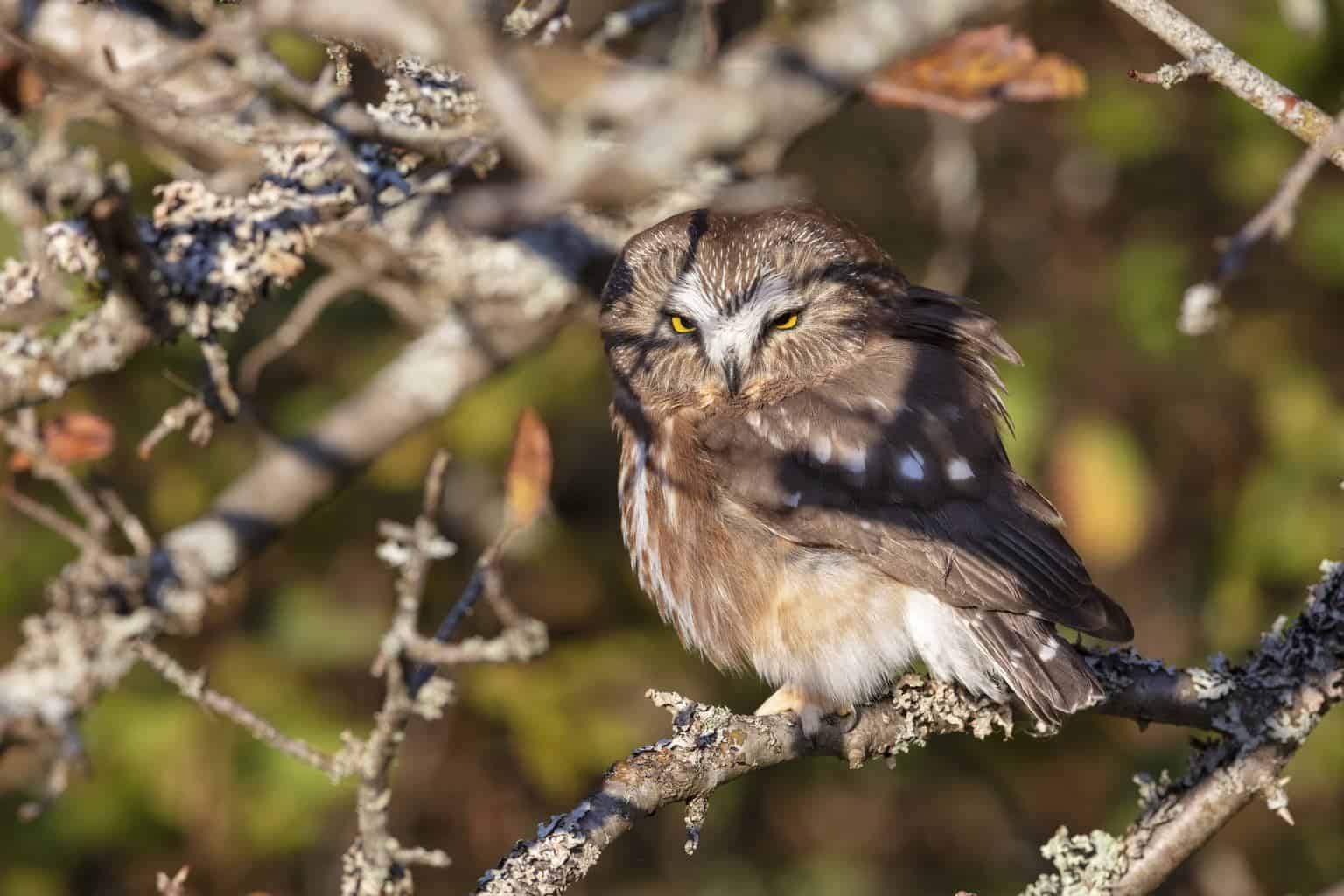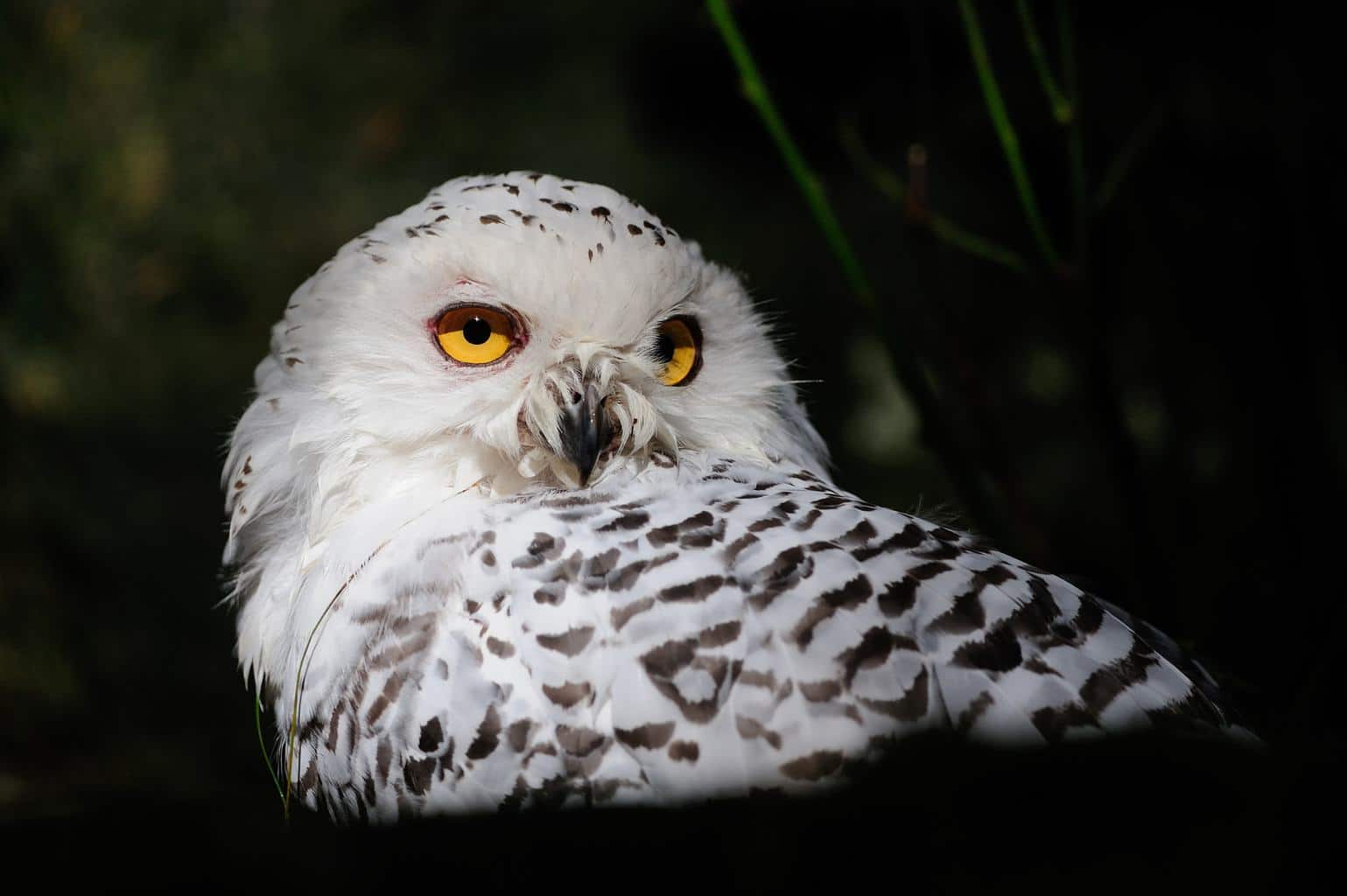If you’re a fan of the musical Hairspray and delicious crab cakes, you probably know a thing or two about Maryland! Almost 41 percent of the mid-Atlantic state is covered in forests, and there are 18 national parks for visitors to explore all year long.
Forests and parks give way for the 450 bird species that live permanently or temporarily in Maryland the ideal space to call home. Among the wide variety of feathered friends in the state are eight individual owl species for the avid birdwatcher to watch and study.
Keep reading, and we’ll tell you everything you need to know about these amazing raptors.
Barred Owl

- Scientific Name: Strix varia
- Length: 16-25 inches
- Weight: 16.6-37 ounces
- Wingspan: 38-49 inches
The barred owl is the most widespread of these birds in Maryland. Also known as the hoot owl, the bird boasts mottled brown and white plumage and barred underparts including the chest. It also has a greyish facial disk and blackish-brown eyes.
This owl lives in mature forests where it spends most of the day perched silently. Its preferred habitat is usually an area that’s near a swamp. At night, the barred owl begins hunting for small mammals and rodents; it might even perch over the water and drop down to catch a fish. The bird also complements its diet with a large number of arthropods and other invertebrates.
The barred owl builds its nest in tree cavities, and the powerful vocalist’s strong and distinctive hoot can be heard from up to half a mile away.
Females of this species tend to get aggressive during nesting season, usually ready to kick an intruder — typically larger hawks or raccoons — with their strong feet. Crows and woodpeckers can also mob and attack the nest, but the barred owl’s biggest predator is the great horned owl.
Great Horned Owl

- Scientific Name: Bubo virginianus
- Length: 17-25 inches
- Weight: 32-88 ounces
- Wingspan: 3-5 feet
Speaking of the great horned owl…this bird is a strong and large predator that often targets prey that’s as large as it is! Also called a tiger owl, this bird has mottled brown-grey feathers, a reddish face, and a patch of white feathers on the throat.
The horns on the owl’s head that give the bird its name and make it easier to identify are actually tufts of feathers.
Great horned owls are sedentary, usually spending most of their lives in a single territory that it defends fiercely. They prefer to live in open areas and orchards, although they can also be found close to swamps.
Birds of this species do most of their hunting at night, and they kill their prey by stabbing them with their talons or crushing them with their strong claws. The claws’ grip is almost as powerful as a German shepherd’s bite!
The great horned owl’s diet is probably the most diverse of all the owls; it feeds on mammals, rodents, birds, amphibians, and fish. The bird probably manages to catch such a wide variety of prey because it’s aggressive; it’s even been known to drive a bald eagle out of its nest and has attacked humans who made it feel threatened.
Northern Saw-Whet Owl

- Scientific Name: Aegolius acadicus
- Length: 6.7-8.7 inches
- Weight: 1.9-5.3 ounces
- Wingspan: 16.5-22.2 inches
The northern saw-whet owl is one of the smallest species found in Maryland. It has an intriguing cat-like face, and its body is covered with mottled brown feathers and sports white spots on its wings.
This owl isn’t easy to find, as it usually roosts in dense vegetation where it’s perfectly camouflaged. However, paying attention to the cries of songbirds will help you find it, as they always warn other birds when it’s roosting nearby.
Often found at eye level, this owl feeds on rodents like deer mice, voles, and shrews. It has asymmetrical ears, and the sound reaches them at two different times. This helps the northern saw-whet accurately determine where the sounds are coming from, improving its odds of having a successful hunting outing in total darkness.
The northern saw-whet owl’s name probably refers to the sound of its call, which resembles the sound of a saw being sharpened on a whetting stone.
Snowy Owl

- Scientific Name: Bubo scandiacus
- Length: 20-25 inches
- Weight: 2.9-5.5 pounds
- Wingspan: 46-65 inches
The snowy owl is also known as the polar or arctic owl. This species is one of the largest owls in Maryland and can be identified by its pure white plumage, although female owls tend to have some brown markings on their bodies. The bird’s eyes are light yellow.
This owl prefers living in open treeless areas. It usually sits on the ground to hunt or perches on a fencepost to get a good view of the surrounding area. Unlike other owls, this one is diurnal and usually hunts lemmings, rats, moles, and other small rodents. Its diet also contains small water birds. It can sense its prey and dig in the snow to catch it.
The snowy owl swallows its prey whole and its strong stomach digests the flesh. The owl regurgitates the indigestible bones, teeth, fur, and hair in compact oval pellets.
The male owl scouts for a nesting location while the female owl builds it. She scrapes out the ground and shapes the nest by pressing her body into the depression.
Long-Eared Owl

- Scientific Name: Asio otus
- Length: 12-16 inches
- Weight: 7.8-15.3 ounces
- Wingspan: 34-40 inches
The long-eared owl is a rather slim bird who sports dark plumage and a slightly orange face. Its ear-like tufts of feathers are black with orange feathers.
The owl’s attractive plumage is perfect for camouflage, which makes the bird rather difficult to locate. It usually spends its time with the slightly larger short-eared owl.
The nocturnal bird’s large hoots and squeals can be heard at night, and during the day, the owl usually roosts silently in dense trees.
The long-eared owl forages in open grasslands and shrublands, and thanks to the bird’s large asymmetrical ears, the owl can precisely locate the source of any sound and pinpoint the exact location of its prey in pitch-black darkness.
Voles make up most of this owl’s diet, but the bird also feeds on pocket gophers and several types of mice. When food is scarce, the owl might feed on lizards, moles, bats, squirrels, and chipmunks.
When it needs a nest, the long-eared owl usually uses those abandoned by other birds, like the American crow or common raven. In some cases, however, it builds its own nest in tree cavities.
Short-Eared Owl

- Scientific Name: Asio flammeus
- Length: 13-17 inches
- Weight: 7.3-16.8 ounces
- Wingspan: 33-43 inches
The short-eared owl is a medium to large-sized bird with buff-brown feathers and white underparts. It has yellow eyes and short ear tufts that are usually difficult to see.
Although most of the owl’s hunting is done at night, the bird is diurnal and crepuscular. It rests on the ground in prairie and coastal grasslands and can usually be seen flying close to the ground.
Short-eared owls’ population tends to fluctuate depending on the abundance of their prey. They usually feed on mice, voles, moles, shrews, and rats, but in some cases, the bird might feed on songbirds and shorebirds.
The short-eared owl looks for a dry site to build its nest, which is usually concealed with low vegetation. When the bird has to leave its nest, it usually defecates on the eggs to drive predators, including the bald eagle and snowy owl, away. Dogs, foxes, and crows might also attempt to steal the short-eared owl’s eggs.
Burrowing Owl

- Scientific Name: Athene cunicularia
- Length: 7.5-11 inches
- Weight: 4.9-8.5 ounces
- Wingspan: 20-24 inches
The sandy-colored burrowing owl has bright eyes and a small body, especially when compared to its large, open habitat. Unlike other types of owls, males and females of this species are of equal sizes.
The burrowing owl travels south in the winter, which gives you a good chance to see it in Maryland. However, finding it isn’t always an easy task, even for an avid birder; the bird’s plumage keeps it perfectly camouflaged.
This owl is active during the day and usually roosts in burrows dug by the prairie dog. It hunts mostly in the hours between dusk and dawn. The burrowing owl can catch insects while flying and sometimes uses its long and strong legs to chase the prey on the ground. Its diet mostly consists of small rodents, amphibians, and songbirds.
Although some burrowing owls dig their own holes, they usually depend on those dug by other animals. During mating season, these owls can also be seen nesting on man-made objects like piles of PVC pipes.
There’s a big correlation between the colonies of burrowing animals like ground squirrels and the presence of the burrowing owl. However, the owl rarely preys upon them.
Eastern Screech-Owl

- Scientific Name: Megascops asio
- Length: 6.3-9.8 inches
- Weight: 4.3-8.6 ounces
- Wingspan: 18-24 inches
Not to be confused with the western screech-owl, the eastern screech-owl is a small owl with reddish-grey feathers and light yellow eyes. The owls are perfectly camouflaged and spend most of their time hiding in nooks and crannies found in tree trunks.
Eastern screech-owls are strictly nocturnal and are usually better heard than seen because of their small size. Most of this species of birds’ hunting is done during the first hours of darkness, especially in open woodlands and along the edges of open fields and wetlands.
You’ll usually find this owl feeding on small mammals, rodents, and birds, and its diet also includes large numbers of earthworms, crayfish, tadpoles, and frogs. In some cases, the bird might also display cannibalistic behavior, but when prey is plentiful, the owl stores the remaining food in tree cavities.
The eastern screech-owl doesn’t mind living close to humans, and it can be found in farmlands and city parks. During the breeding season, a mating pair will also nest in manmade bird boxes in your backyard or occupy cavities excavated by woodpeckers and squirrels.
Wrap Up
Your trip to Maryland can serve as an excellent opportunity to learn more about the amazing and wide variety of birds that make this state their home. Although owls aren’t easy to find, an avid birdwatcher knows they’re definitely worth the effort; just keep your eyes and ears open!

